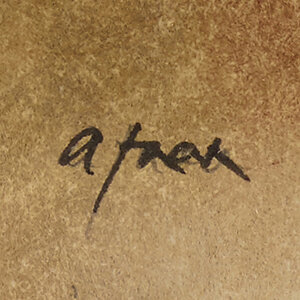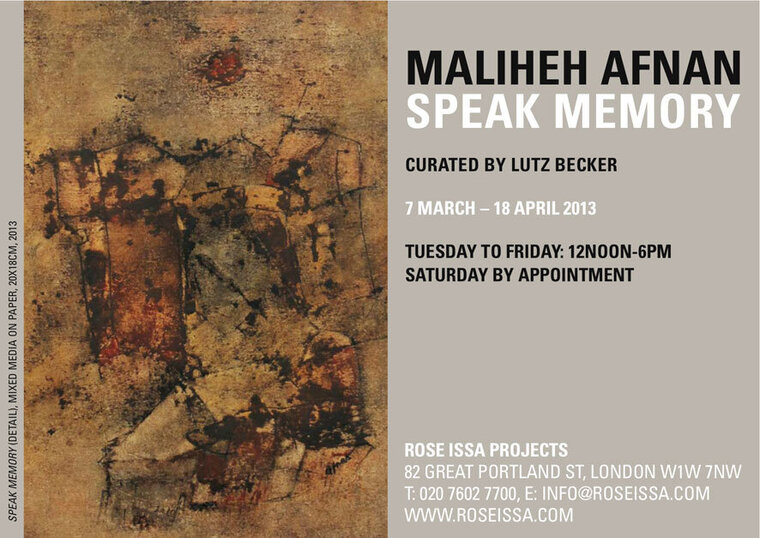


Last updated on Thu 7 March, 2013


MALIHEH AFNAN: SPEAK MEMORY
ROSE ISSA PROJECTS
March 7 – April 18 2013
82 Great Portland Street
London W1
Curated by Lutz Becker
“The pages are still blank, but there is a miraculous feeling of the words being there,
written in invisible ink and clamouring to become visible.” ---- ---- - - ------ Vladimir Nabokov
Maliheh Afnan writes her paintings. She has an instinctive affinity with paper. Her inspiration flows from her Middle Eastern roots, from her deep attachment to the tradition of calligraphy and her knowledge of the mysteries of the ancient languages of the region. Her painterly script, which she refers to as écriture, is in essence a linear accumulation of signs. Her lines appear in single formations, in clusters or in ordered configurations, in a script seemingly written by time itself. The signs, gestures, and repetitive movements of micro-calligraphic marks contain great expressive energy. Each line, each mark has a value, a meaning within the total image. In these paintings, forces of concentration, dispersal and transformation are at work. Calligraphic elements emerge from deep earth-coloured surfaces that have been built up layer by layer like palimpsests. Composed in fluent rhythms, Afnan’s scriptural structures seem to illuminate unspoken poems. Successions of pre-representational signs of abstract informality refuse to refer to any subject.
Explaining her approach, the artist says: “Script, in its essence, is abstract. I don’t turn it into an abstract, it is abstract. Written in the Persian or Arab language, calligraphy has been a very highly developed art form. By tradition calligraphy is about the worship of words through writing them. But this writing had always to be readable. I was never interested in the literal meaning of the text.”
The act of writing, of making an image, its very emergence and permanent presence as an image, is its sole purpose and resolution. These paintings are active colour fields in which lines and varying densities of pigment produce subtle interactions. Lines and scriptural rhythms combine with modulations of layers of colour, their interplay creating vibrating dynamic surfaces. In these pictorial spaces, rhythmical values transcend structure and materiality, creating an environment that invites reflection, meditation, silence.
The artist has been influenced and formed by both East and West, the old Mediterranean culture and the impact of the Western modernist avant-gardes. In pursuit of her imago, her inner image, the artist’s work flows unconsciously into the creation of a universal dimension in which presence and past meet. Calligraphy, the art of writing converted into an abstract language, has been her main source. But another inspirational impulse is as important for the understanding of her work. This is her love for the textures and colours of the ancient ruins of the Middle East and North Africa; for the terracotta shards found in the desert sands with fragments of glyphs and writings on them. But this experience too may have been extended and altered by seeing and admiring the colour of rust in our industrial cities.
As in the works of Paul Klee and Mark Tobey, line has predominance in Afnan’s work. While in Paris in the 1970s she began to make a number of haunting drawings and paintings of faces in a series she calls Personnages. They are not portraits but represent imaginary features that seem to summarise the state of melancholy and displacement. These Personnages are mostly male. They seem to exist suspended in time. Their faces are like landscapes marred by tragic histories and broken lives. In silent knowledge of loneliness and suffering, they seem to look at us from windows of ruins. They are like Nicolai Gogol’s lost souls, victims and witnesses who have emerged from the dust of unknown streets. Afnan’s work embraces different time. Placed in real time are making, being and becoming; the sphere of mental time belongs to inspiration and subjective perception. The artist’s experiences of her own lifetime and memory, measured against the yardstick of historical time, reverberate for ever present in her paintings.
“The notion of memory is a central theme and motive in my work. I would say my work is rooted in memory, both in my own and perhaps collective memory. Unconsciously but continually I refer to places, scripts and faces from the past, both real and imagined. If all of one’s life is registered in the recesses of the unconscious, then one’s work might simply be an unravelling, filtering and transforming of memory through time. Memory is very real.”
Lutz Becker, London 2013

This exhibition is kindly supported by Chateau Marsyas
as part of its Arts & Culture programme
Join us in our endless discovery of modern and contemporary Arab art